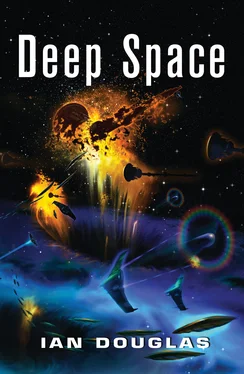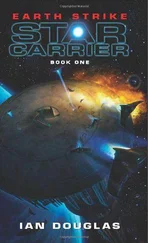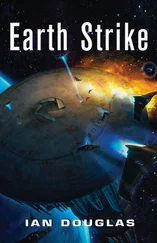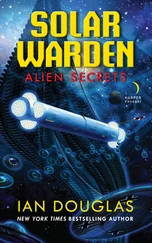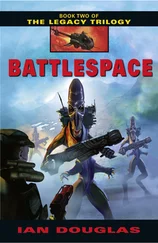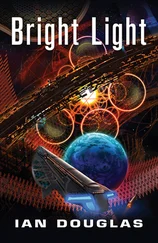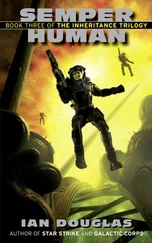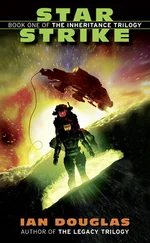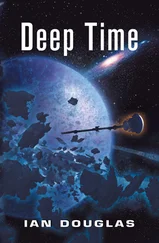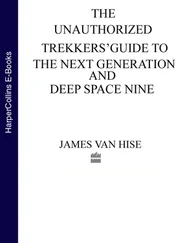Midpoint. Surrounding space slewed wildly across 180 degrees, and now a vastly shrunken Earth lay directly ahead, but still dwindling in apparent size. Forty-two and a half seconds after boost, the Black Demons were now traveling at over 850 kilometers per second. Still pulling two thousand gravities, they were decelerating now, backing down toward their destination.
The Sh’daar War had lasted for thirty-eight years, from the time the Agletsch had delivered the Sh’daar Ultimatum until Admiral Koenig’s brilliant and unexpected victories at Texaghu Resch and Omega Centauri. Most civilians thought of the war now as history, while most military personnel were content to wait and see. By any reasonable assessment, the Sh’daar represented a technology some thousands of years in advance of Humankind, and yet they had just stopped.
Smart money said that they weren’t yet done with the upstart Earth Confederation.
Slowing rapidly, the Black Demons drifted tail-first past the collection of spheres, struts, holding tanks, domes, and rotating hab modules that comprised the synchorbital part of the Quito space elevator. Anchored deep in the solid rock of Mt. Cayambe, on Earth’s equator 36,000 kilometers below, the elevator had offered cheap, easy, and high-volume access to space since the early twenty-second century.
The synchorbital naval base was located a dozen kilometers from the upside terminus of the elevator, a vast structure including hundreds of docking spaces and gantries for military vessels. A joint project of the Confederation and the United States of North America, it housed some thousands of military personnel, as well as home port facilities for those warships, the bigger ones, unable to enter planetary atmospheres.
Largest of these was the TC/USNA star carrier America .
Mushroom-shaped—1,150 meters long—CVS America was docked at a special gantry offering multiple mag-tube access for personnel and supplies. The forward cap, 500 meters across and 150 deep, served as both radiation shielding and as a holding tank for 27 billion liters of water, reaction mass for the ship’s maneuvering thrusters. The slender, kilometer-long spine held quantum-field power plants, maneuvering thrusters, and stores, while two hab rings, counter-rotating and tucked in close behind the shield cap, carried the ship’s human complement of 4,840. Around her, like swarming midges, a cloud of drones and remote vehicles kept watch, or serviced her external hull.
“VFA-96,” a new voice said. “You are cleared for two-by-two trap in Landing Bay One. Please alter your hull shape to facilitate capture.”
It was a woman’s voice, but with the precise diction and phrasing that likely indicated an AI, an artificial intelligence.
“Copy. Black Demons on docking approach,” Mackey’s voice said. “Morphing from sperm mode to turkey. Okay, people. Switch to AI approach.”
Maneuvering to approach over the immense vessel’s stern, the Black Demons shifted their hull structure from their high-boost configuration—popularly known among the pilots as “sperm mode”—to flight mode. The nanomatrix hull of an SG-92 allowed the craft to mold itself into a variety of shapes during flight. In atmospheric or flight mode—“turkey mode” in the pilot lexicon—growing wings that better allowed the landing bay magnetics to trap inbound fighters. Massing just twenty-two tons—her usual weapons loadout massed more than that by a considerable margin—the bulk of Gregory’s Starhawk flowed like water at his thought command, extending delta wings, negatively charged to give the flight deck something to grab.
The first two fighters, Lieutenants Anderson and Rivera, dropped into their final approach side by side, sweeping up along America ’s spine from tail toward the base of the mushroom cap. The next pair followed twenty-eight seconds later—Esperanza and Nichols—followed by Mason and Del Rey.
Next up on the list were Gregory and his wingman—Lieutenant Jodi Vaughn. Fighters didn’t use their gravitational drives for maneuvering close aboard a carrier, not when the microscopic knot of a twisted spacetime comprising the craft’s drive singularity could shred the fabric of a capital ship’s hull like a particle cannon. Cutting their drives, Vaughn and Gregory opened aft venturis and fired their maneuvering thrusters. Jets of plasma, using super-heated water as reaction mass, bumped them into their final vector at three Gs—a kick unlike the free-fall acceleration of a gravitational drive.
Dropping into a landing approach, Gregory’s AI adjusted his ship’s velocity as America ’s long spine blurred overhead. The landing-bay entrance yawned wide ahead, rotating around to meet him, his onboard AI microadjusting his velocity and attitude to meet it. The landing bay was rotating at 2.11 turns per minute, providing the module’s out-is-down spin gravity. The bay’s entrance swung around every twenty-eight seconds, just as each incoming fighter pair was there to meet it.
Traveling at 100 meters per second, they flashed into the shadow beneath the carrier’s spine, the domes, blisters, and sponsons housing the ship’s drive projectors blurring past, seemingly just above his head. It took them almost ten seconds to traverse the length of America ’s spine. At the last instant, his AI tapped his starboard-side thrusters to find the moving sweet spot that matched perfectly the 7-meters-per-second lateral movement of the rotating landing bay. The moving opening ahead suddenly appeared to freeze motionless in space, as Vaughn and Gregory flashed across lines of approach-acquisition lights.
When the fighters hit the flight deck’s magnetic tangle-field, he felt again a sudden shock of deceleration, and the side-by-side fighters came to rest. Magnetic grapples embraced his fighter and moved it forward to a nanosealed patch on the deck. A moment later, he was dropping through the seal to the pressurized deck one level below.
His neural feeds cut out, and abruptly Gregory was enfolded in a tight, close, suffocating darkness. He thoughtclicked the cockpit open, and the hull melted away around him as he emerged into the bustling noise and glare and movement of the pressurized hangar bay. A robot, all arms and spindly plasteel framework, met him on the access scaffolding, its optics adjusting independently as it scanned him and his fighter. “Welcome aboard, Lieutenant,” the machine said.
“Move your metal ass, damn it,” a human flight chief said nearby. As the robot shifted to one side, a crew chief appeared. “Hey, Lieutenant. Welcome aboard the America .”
Gregory removed his flight helmet, blinking under the harsh lighting filling the cavernous space, and nodded. “Thanks, Chief.”
He wasn’t home, but maybe, maybe , someday, if he was lucky, the star carrier America would get him there.
TC/USNA CVS America
USNA Naval Base
Quito Synchorbital
1440 hours, TFT
“VFA-96 is recovered, Captain,” America ’s CAG reported.
“I see it, Connie. Thank you.”
Back on board his ship, now, after the shuttle flight up from Columbus, Captain Gray relaxed in the embrace of his command seat on the carrier’s bridge, allowing incoming streams of data to flood through his consciousness. With his cerebral implants hardlinked to the carrier’s artificial intelligence, he could follow all of the preparations for getting the immense vessel ready for debarkation directly, as though he himself was the central awareness of America ’s AI network. Through the AI’s electronic eyes, he’d watched the Starhawks of VFA-96 hurtling in, two by two, and trapping on America ’s Bravo flight deck. A shift in perception, and he was watching now as the Starhawks peeled open and the pilots emerged.
Читать дальше
